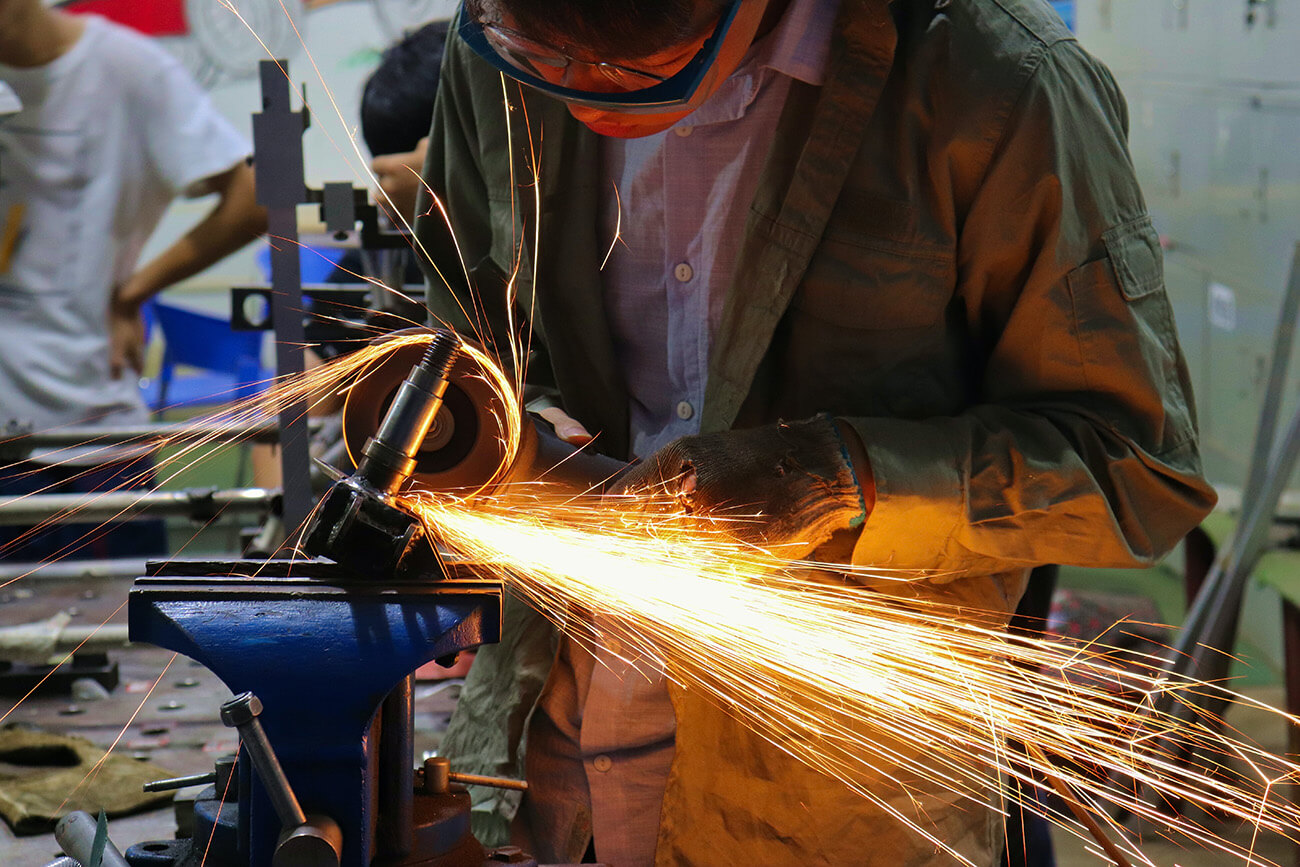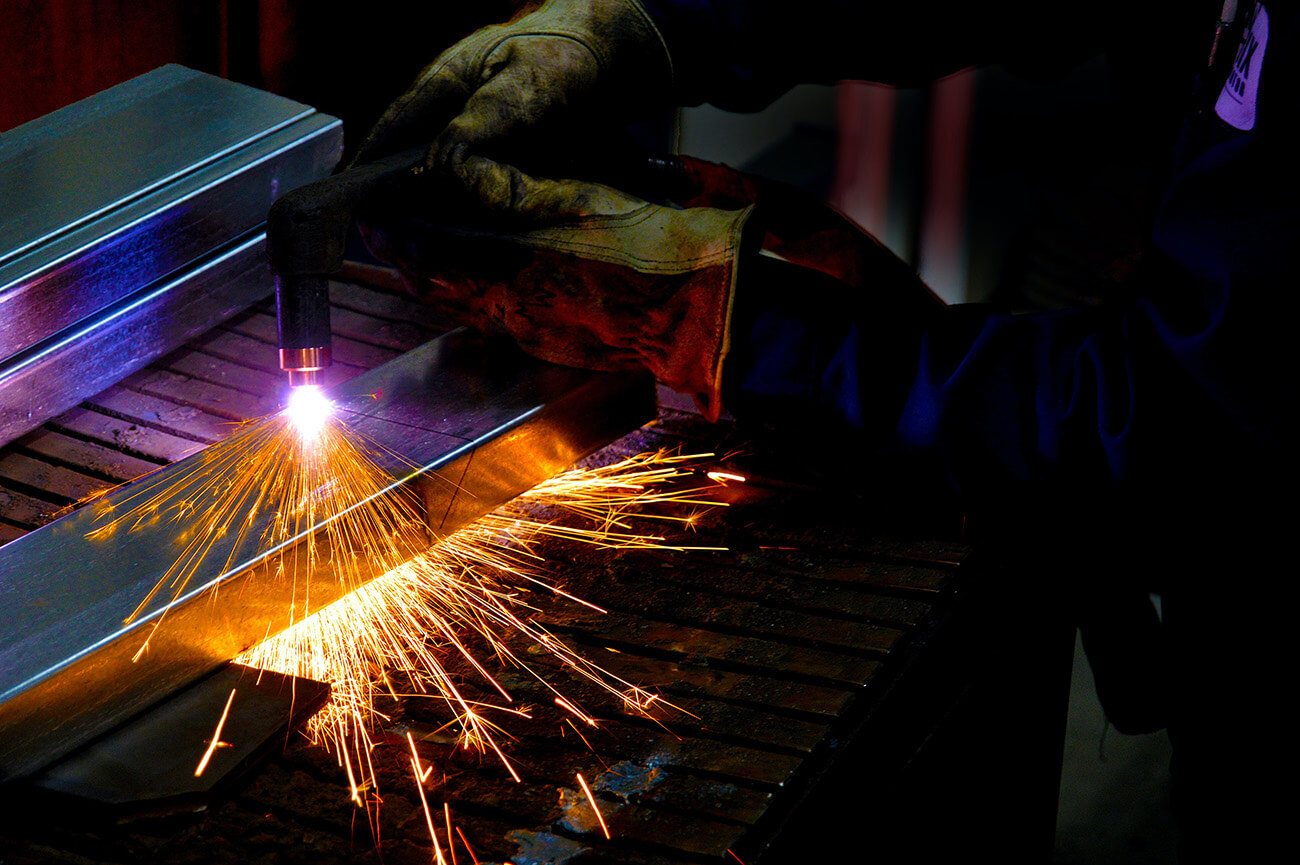TIG welding, also known as Gas tungsten arc welding (GTAW), is a process that joins metal and other materials by heating them at a very high temperature with help of an arc between electrode which is of tungsten and workpiece. This process accompanied by a shielding gas and can be done with and without the help of filler metal.
The main things to control this process are arc voltage, current, speed, and shielding gas composition. The production amount by the arc is very high and directly related to current, voltage, and energy transferred per unit length is inversely related to the speed of travel.
Shielding gases are more inert which can protect the electrode from contamination. Helium shielding is more preferred than argon shielding.
The arc established between the tip of the electrode and workpiece can generate enough heat to melt the metal. After the establishment of arc, the torch is moved along the joint and melts the surface to be joined.
If filler metal is used to weld the joint, then this process is fast. Sometimes, the electrodes are alloyed with active elements to increase the emissivity rate of the electrode.
History of TIG Welding
After the discovery of short-pulsed electric car by Humphry Davy in 1800 and continuous electric arc in 1802 by Vasily Petroy, slowly the idea of arc welding gives a thought about inert gas welding in 1890, but non-ferrous metals such as aluminum and magnesium can’t be welded because they react with air very fast and result in non-uniform welds like porous, dross filled welds.
To solve this problem, in the early 1930’s, a bottled inert gas used. Russel Meredith perfected this process in 1941 of using a tungsten electrode arc and helium as a shielding gas, which is nowadays referred to as TIG Welding (Tungsten Inert Gas Welding). After that, The American Welding Society named it as gas tungsten arc welding (GTAW)
Limitations of arc welding
1. The speed of travel and deposition is very low, which results in increasing the cost of welds.
2. A very skilled operator required to produce quality welds.
3. This process requires large manpower to work and it can’t be automated.
Applications of TIG
Nowadays, TIG welding is used in all industrial centers, but especially it is used for high-quality welding. The main industries that use TIG welding are
1. Aerospace
Airplanes and spacecraft designed in parts and then joined together by means of tig welding. As commercial planes used everywhere, also complex craft like International Space Station has been taken benefits from many processes like Tig welding, which have the greatest strength and accuracy.

2. Automotive
In the auto industry, safe and secure constructions is very essential, for making vehicles stand for the most of time. TIG welding also used in the automotive industry.
These strategies help to lessen corrosion. Manufacturers use this technique to make their cars corrosion-free.
Also, it will be safer for the customer to travel in it if its construction material and manufacturing safe.

3. Repair
Tig welding used in many repair applications like fixing a toy to weld the petrol car and to repair tools. It is also common in many repair shops for its effectiveness.

4. Manufacturing of mechanical parts
Tig welding used in manufacture in many parts. However, there are some other methods available for orbital rotations. This mechanism requires no man skill, but the operator would be very well trained. Because any negligence will cause much harm to the person and material on which work is done.

Advantages
TIG welding has many advantages over simple welding. The advantages are
1. Can Weld more metals and alloys
Tig welding used to weld many more metals than steel, stainless steel, aluminum, nickel alloys, copper, magnesium, bronze, and brass. It is a very useful process for welding different vehicles like lawn mowers, wagons, handles, fenders, and many more.
2. Clean Welds
Having a superior arc and good control, TIG makes you able to weld more metals cleanly in appearance. The reason is that the heat input controlled by putting a load on the paddle, just like driving a car.
It allows you to cool down or heat up the weld puddle which gives you the very accurate weld control. This is the reason for making TIG welding a very ideal method for sculptures and automotive leads.
3. No sparks or spatter
The reason for no sparks and spatter is that the filler metal added in a welding puddle only in moderate quantity.
4. No flux or slag
The presence of argon and helium gas in shielding gas prevents the weld puddle contamination. So, no flux required to fasten the process, and no slag produced which can block your view of the weld puddle. Also, there will be no slag remain after the welding process completed.
5. No smokes or fumes
The simple welds create smokes or fumes which are not healthy for your health. Tig welding does not create any kind of smoke or fumes until the base metal reacts with metal which is being welded.
This metal contains contaminants or many other elements such as oil, grease, paint, and lead. So, to make sure no smokes or fumes occur, the cleansing of base metal is necessary.
6. Welds in any position
Tig welding can make you weld in all possible positions i.e. flat, vertical, horizontal, or overhead. It is perfect for al cages and inner tight areas.
7. Uses one shielding gas for all applications
Helium and argon gases are suitable shielding gases for all the applications of TIG welding. Also, you will need the only type of gas to handle all your welding projects.
Disadvantages
1. It is a slow and very time-consuming process. They are slower than any other process of welding.
2. Tig welding is a bit complex process. A person who does tig welding must be highly trained.
3. There will be more safety issues. Welders exposed to the high intensity of light which will cause damage to their eyes.
4. Very expensive method.
5. It requires very thick sheets of metal.
Requirements for tig welding
Before starting the process of tig welding, there are some requirements for TIG welding. Some material and stuff that you should have before starting the welding.
1. Machine setting
Your machine should be set at straight polarity for all types of workpiece whether it is aluminum or magnesium. The high frequency used in inverters, these days also post flow of the material set before 10 seconds minimum.
If aluminum needs to weld, then the polarity and amperage range set at normal values i.e. in AC it is 7 and high-frequency supply are continuous.
2. Shielding gas
There is a need for inert gas i.e. shielding gas to prevent the welding area to be contaminated.
In most of the cases, it is helium or argon. For only welding of aluminum, there is a need for a 50/50 combination of argon and helium but the combination is different for each other element. It should be set at 15 cm.
3. Torches
For the process of welding, there is a need for a torch and the torch comes in two different types.
- air-cooled torches
- water-cooled torches
These torches come in different sizes in the market according to the requirements of users.
Unless you are the expert of TIG welding, TIG torches are best to use. Different settings of current are available for different torches.
4. Electrodes
For TIG welding, the electrode is very necessary. An electrode made of tungsten used in this kind of welding. It is very sharp and clean. Mostly, a belt sander of 4.5 inches is sufficient.
If you are welding aluminum, then just rub the workpiece with the sander. For welding, any tungsten electrode which requires less than 90 amps of AC current is good enough current supply.
For the current range above 90 amps, we require a 3/32 tungsten electrode while for any current range beyond 200 1/8 tungsten electrode id enough.
5. Welding rods
For TIG welding, three different rods are preferable.
- The 308 rods used for stainless steel
- E70S2 used for mild steel or for aluminum
- 4130, and 4043 used for both actions.
These rods are enough to weld any kind of material.
But under some situations, some specific rods only used for that specific purpose. You’ll have to read all the guidelines and instructions before using them.
Best technique for TIG welding
There are many techniques for TIG welding, but every operator set according to their ease and requirement.
Tig welding is the most favorite technique of welders because it is easy to hold like a pen even on 10 degrees.
Tip of tungsten can lift to 1/4 inch of metal for comfortable operation.
Wear your helmet and press the pedal. As soon as the arc generates, increase the heat by pedaling and the further process will be gradual and smooth welding in terms of transitions.
Conclusion
Among all the other welding choices, TIG welding has proved to be the most efficient and less hazardous technique until now. It is cost-efficient and has less expense for the material required.
It is the safest option for the workers who constantly exposed to heat and hazardous radiations coming out from welding. So in my opinion, TIG welding is the better choice than any other simple welding for the people who have their business of welding.

